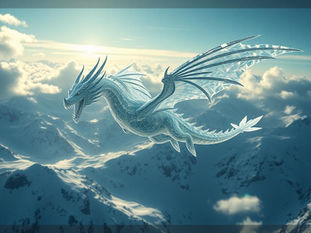
Unlock the Full Potential of Midjourney: A Guide to Parameters
Apr 22
4 min read
0
2
0

Midjourney is a powerful tool for generating images from text prompts. To get the most out of it, you need to understand its parameters. Parameters let you control things like aspect ratio and which model to use. Let's explore these parameters to create amazing visuals.
Understanding Midjourney Parameters
When you submit a text prompt to Midjourney, the system uses default settings. You can change these defaults by adding specific parameters to your prompt. Parameters always start with two dashes, followed by the name or abbreviation, a space, and the value. For instance, to create a 3:4 image, you'd use the aspect ratio parameter like this: --aspect 3:4. Remember to put parameters at the end of your prompt and separate them with spaces. There are lots of hidden ways to improve your Midjourney workflow! Did you know that you could automate your parameter inputs? Check out the Midjourney Automation Suite from TitanXT to learn more about streamlining your process!
Version Parameter
The version parameter determines which Midjourney model generates your images. To use a specific model, add --version or --v followed by the model number (e.g., --v 5). Each model has its own unique style and prompt understanding. Trying different versions can be fun to see how Midjourney has changed over time. Current values include 5, 5.1, 5.2, 6, and 6.1. There are also test models like --test and --testp, and anime-trained models like --niji followed by the model number.
Aspect Ratio Parameter
Aspect ratio defines the width and height relationship of your image. It's written as width:height. The default is 1:1 (square). Change it using --aspect or --ar followed by the ratio (e.g., --ar 16:9). Use whole numbers, and remember there are limits to how tall or wide your images can be. For V6 models, you can go up to approximately 14:1 or 1:14.
Chaos Parameter
Chaos affects the diversity of the images in your grid. The parameter is --chaos or --c. The default value is 0, and it ranges up to 100, which is maximum diversity. Using chaos can add unpredictable, interesting results. This is a great way to add unique elements to your images. If you're wanting to create new and interesting images with parameters, maybe automating the image creation process is what you need. With the Midjourney Automation Suite from TitanXT you can input parameters on autopilot. Check it out today!
Style-Related Parameters
Midjourney offers several parameters to control the style of your images.
Stylize Parameter
Stylize, or --stylize or --s, controls the strength of Midjourney's default visual style. The default value is 100, and the range is 0 to 1000. Higher values create more stylized results but might reduce prompt accuracy. This parameter is also used with personalization.
Style Reference Parameter
Style reference, or --style_reference or --sref, is a powerful feature. It applies aesthetic elements like color palette, texture, and overall style from reference images to your results. You can use image URLs, sref codes, or the word "random" after the parameter. Style weight, or --sw, controls the influence of the style reference, with a default of 100 and a range of 0 to 1000. There's also style version, or --sv, relevant for V6 models when using image URLs as style references.
Style Parameter
The style parameter, or --style, lets you minimize Midjourney's influence on the results. Style raw is often used for more photorealistic images. If using V5 models, you can use Style with the V5 style codes. Niji models also have different style modes affecting aesthetics.
Other Important Parameters
Let's look at other key parameters that can enhance your Midjourney experience.
Quality Parameter
The quality parameter, or --quality or --q, controls the amount of time Midjourney spends generating your images. The default is 1. Lower values mean faster generation but less detail, while higher values mean slower generation but more detail. Different models accept different values.
Speed Parameters
Turbo, fast, and relax control image generation speed. Turbo and fast use your fast GPU hours, while relax doesn't. You can set your default speed in settings but override it with parameters. Repeat, or --repeat or --r, runs the same prompt multiple times in fast or turbo mode. Do you find yourself repeating tasks often? The Midjourney Automation Suite from TitanXT is a great way to minimize your work and maximize your output. Start automating today!
Video and Stop Parameters
The video parameter, or --video, creates a short time-lapse of your initial image grid being generated. Use it on Discord and react with the envelope emoji to get a direct message with the video link. Stop, or --stop, ends image generation early, taking values from 10 to 100. This is useful for softer, more abstract results.
Image Weight and Character Reference
Image weight, or --iw, is used with image prompts to control the influence of the images on your results. The default is 1, and it takes decimal values between 0 and 3 in V6. Character reference, or --cref, matches a character from a reference image. Character weight, or --cw, controls how closely Midjourney follows the clothing and hairstyle of the reference character, ranging from 0 to 100.
Personalization and No Parameter
Personalization, or --p, lets you create your own custom Midjourney model. You first need to teach Midjourney about your style. When enabled, your personalized model overrides the default Midjourney style. The no parameter, or --no, tells Midjourney what not to include in your image. Separate multiple items with commas.
Tile, Seed, and Weird Parameters
Tile, or --tile, creates repeating patterns. Seed, or --seed, uses a specific seed number for consistent results. Weird, or --weird or --w, creates strange and unexpected results with values up to 3000.
Conclusion
Midjourney parameters are essential for controlling and customizing your image generation process. By understanding and using these parameters, you can create unique and compelling visuals. Experiment with different settings to discover what works best for your creative vision. Want to automate the creation process? Check out the Midjourney Automation Suite from TitanXT to learn more!






